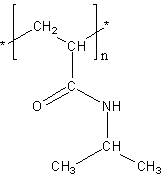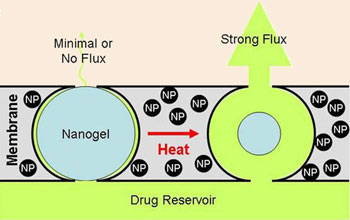A group of researches has created a hydrogel membrane that “opens†and “closes†in response to magnetic flux. The discovery could lead to delivery systems capable of precision drug therapy for a host of conditions.
RSC.org:Â A team led by Daniel Kohane of Harvard Medical School in Boston, US, harnessed the thermosensitive properties of poly(N-isopropylacrylamide) (PNIPAM) to form the basis of the new system. This material can form a hydrogel which is swollen in its native state but which collapses upon heating.
The researchers embedded nanoscale particles of PNIPAM-based gels in an ethyl cellulose membrane so that clumps of the particles spanned the width of the membrane. They also entrapped magnetite nanoparticles within the membrane matrix.
If the membrane is exposed to an oscillating magnetic field, the magnetite nanoparticles heat up, in turn warming the PNIPAM by a few degrees – sufficient to cause the particles to collapse but not so high as to affect surrounding tissue. This leaves voids in the membrane, opening up channels from one side to the other.
In this way the membrane’s porosity can be remotely switched on and off. To demonstrate the potential effectiveness of the system in drug release, the research team encapsulated the dye sodium fluorescein in the membrane and implanted it in rats. They showed that the membrane remained intact and ‘switchable’ over multiple cycles, that the amount of dye released was in proportion to the length of time that the magnetic field was applied, and that the membrane was non-toxic and biocompatible. By modulating the magnetic field it should be possible to fine-tune the rate of drug release, in addition to the frequency and duration of treatment.
 Poly(N-isopropylacrylamide) (PNIPAm) is a an interesting polymer that has frequently been used in research as a possible drug delivery tool. When crosslinked with certain materials, in this case ethyl cellulose, it can form three-dimensional hydrogels capable of carrying a drug. At cooler temperatures the hydrogel remains hydrated, but when exposed to higher temperatures the membrane collapses, expelling the material held inside.
Poly(N-isopropylacrylamide) (PNIPAm) is a an interesting polymer that has frequently been used in research as a possible drug delivery tool. When crosslinked with certain materials, in this case ethyl cellulose, it can form three-dimensional hydrogels capable of carrying a drug. At cooler temperatures the hydrogel remains hydrated, but when exposed to higher temperatures the membrane collapses, expelling the material held inside.
The researchers responsible for the latest breakthrough were able to control the release of sodium fluorescein from the PNIPAm hydrogel through the use of an oscillating magnetic field. This is particularly exciting because the drug delivery was directly proportional to the duration of the pulse. The researchers also discovered that they could stop the release of material from the hydrogel by removing the magnetic flux, basically shutting off the valve. Cool!

Leave a Reply